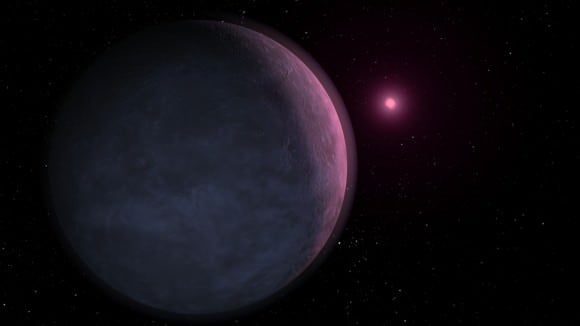[/caption] In June of 2008, astronomers
announced the finding of one of the smallest exoplanets yet around a normal star other than the Sun.
The planet – believed to be a rocky exo-world -- was found through a microlensing event, and was estimated to be 3.3 times the size of Earth, orbiting a brown dwarf star. But new analysis suggests the star may be larger than first thought, making the planet smaller than the original estimates. Astronomers say the exoplanet, called MOA-2007-BLG-192-L b could weigh just 1.4 Earths - less than half the original estimate. Observations over the next few months should be able to test the prediction.
Most known "exoplanets" are huge gas giants, hundreds of times Earth's mass, and are discovered by detecting the wobble they induce in their parent stars.
But researchers found the planet and star using the gravitational microlensing technique. This is where two stars line up perfectly from our point of view here on Earth. As the two stars begin to line up, the foreground star acts as a lens to magnify and distort the light from the more distant star. By watching how this brightening happens, astronomers can learn a tremendous amount about the nature of both the foreground and background star.
In this case, there was an additional gravitational distortion from the planet orbiting the foreground star MOA-2007-BLG-192L, which astronomers were able to tease out in their data.
However, analyzing these events takes time, because there are so many variables to take into account, including the sizes of planet and star, their separation, and the distance from Earth.
Initially, the team believed that this host star was a brown dwarf - an object too small to sustain nuclear fusion, as normal stars do. That suggested MOA-2007-BLG-192-L b weighed 3.3 Earths.
But more recent observations suggest the parent star is actually heavier than first thought - a type of star called a red dwarf, team member Jean-Philippe Beaulieu of the Paris Astrophysical Institute reported last week at a meeting of the Royal Astronomical Society in London.
That suggests the planet weighs just 1.4 Earths. In size terms, that makes it a near twin of our own planet, closer in mass than any known planet except Venus.
"The result is important because this is the lowest-mass planet yet detected, and is extremely close to the mass of the Earth," said Scott Gaudi of Ohio State University in Columbus. "Obviously, finding a true Earth-mass planet is one of the biggest goals of searches for exoplanets. We are very close to that goal now." [caption id="attachment_23895" align="aligncenter" width="250" caption="Very Large Telescope Facility. Credit: ESO"]
[/caption] The team will attempt to get more data on the parent star in April or May using the Very Large Telescope in northern Chile.
If their analysis is confirmed, it is an unclear whether the tiny planet could host any life. Because its host is a very dim red dwarf, the planet is likely to be frozen - even though it orbits at about the same distance as Venus from our Sun.
However, if the planet boasts a thick, insulating hydrogen atmosphere, it could sustain a habitable surface temperature, capable of supporting life of some kind.
Source:
New Scientist
 Universe Today
Universe Today
